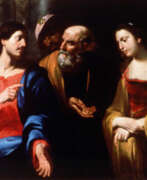Portraitist Tenebrism


Orazio de Ferrari was an Italian artist, active in the Baroque period, born in Voltri, a suburb of Genoa. De Ferrari was a pupil of Giovanni Andrea Ansaldo. He was a member of the family of Genoese artists, with surnames de Ferrari, which also included Giovanni Andrea de Ferrari and Gregorio De Ferrari. During the 17th century, he painted murals in the chapel and many of the state rooms of the Royal Palace in Monaco.


Francesco Cairo, also known as Francesco del Cairo, was an Italian Baroque painter active in Lombardy and Piedmont. It is not known where he obtained his early training though he is strongly influenced by the circle of il Morazzone, in works such as the Saint Teresa altarpiece in the Certosa di Pavia. Many of his works are eccentric depictions of religious ecstasies; the saints appear liquefied and contorted by piety. He often caps them with exuberant, oriental turbans.


Carlo Saraceni was an Italian painter, renowned for his contributions to the Baroque art movement. Born in Venice around 1579, Saraceni spent a significant portion of his career in Rome, where he was deeply influenced by the works of Caravaggio and Elsheimer. His art is celebrated for its vivid naturalism and meticulous detail, reflecting the stylistic transitions of early 17th-century Italian painting.
Saraceni's ability to blend Venetian colorism with Roman naturalism allowed him to create works that resonated with patrons across Europe, securing commissions from prominent ecclesiastical and aristocratic figures. His paintings, such as "Judith and the Head of Holofernes" at the Kunsthistorisches Museum in Vienna and "Saint Sebastian" at the Picture Gallery of the Prague Castle, showcase his mastery in depicting biblical and mythological scenes with emotional depth and realism.
Notably, Saraceni's work "The Dormition of the Virgin" was commissioned to replace a rejected painting by Caravaggio, indicating his stature and recognition in the artistic community of Rome. This commission highlights the nuanced differences in interpretation and representation of religious themes that distinguished Saraceni's approach from Caravaggio's.
Throughout his career, Saraceni remained connected to the vibrant artistic scene in Rome, engaging with the broader European context through his international relations. His legacy is preserved in the numerous works held in galleries and museums worldwide, reflecting his enduring influence on the Baroque art movement.
For art collectors and experts, Saraceni's oeuvre represents a pivotal moment in the transition of artistic styles, offering a rich tapestry of themes and techniques that continue to inspire and captivate audiences.
To stay updated on new product sales and auction events related to Carlo Saraceni's works, consider signing up for updates. This subscription is a great way to remain informed about opportunities to engage with the art and legacy of this influential Baroque painter.

